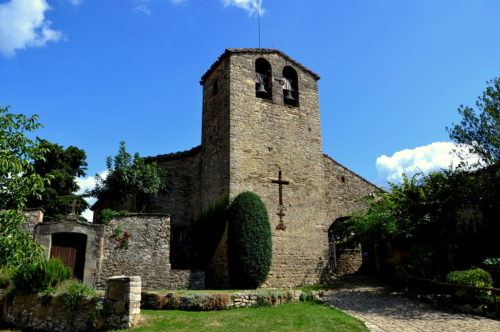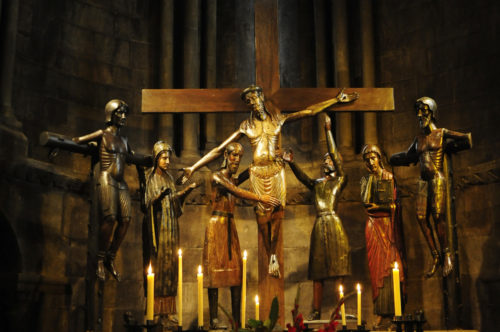Distance and time: Tavertet-L’Esquirol (22,1km-41min) | L’Esquirol-Sant Pere de Torelló (35,5km-1h 7min) | Sant Pere de Torelló-Sant Joan de les Abadesses (65,1km-1h 31min)

CHURCH OF SANT CRISTÒFOL (ST.CHRISTOPHER) DE TAVERTET
-Address: Carrer del Mig, 2, 08511 Tavertet, Barcelona
-Contact: 938 565 079 | tavertet@diba.cat | www.tavertet.cat
-GPS Coordinates: N 41º 59’ 44.865” E 2º 25’ 1.103”

The parochial church of Tavertet at the end of this tiny village. Its apse it built right on the edge of the cliff.
Car parking: For a small fee, it is best to leave the car in the car park on your right, as you arrive at Tavertet.
Nearby services: The church is in the centre of the village where there are restaurants, a little shop and a café.
Entrance fee:
Free
Opening times:
The church is open at weekends from 9.30AM to 20.30PM.
Other things to do:
The cliff views from Tavertet are amazing. It is worthwhile taking the time to visit Sant Bartomeu Sesgorgues and Sant Miquel de Sorerols, two little mountain chapels. For more information visit: www.tavertet.cat
MONASTERY OF SANT JOAN (SAINT JOHN) OF LES ABADESSES
-Address: Pl. de l’Abadia, s/n – 17860 Sant Joan de les Abadesses, Girona
-Contact: 972 722 353 | info@monestirsantjoanabadesses.cat | www.monestirsantjoanabadesses.cat
-GPS Coordinates: N 42º 13’ 57.591” E 2º 17’ 9.941”

Its church is one of the Jewels of Catalan Romanesque Art, the ‘Extremely Saintly Mystery’ or Santíssim Misteri,’ a historic must for pilgrimage. Founded in 885 by Guifré el Pelós and led by his own daughter, Emma, and the Abbot Oliba was greatly influential in obliging the convent to cease to be for women, due to the accusation that the nuns were leading a dishonest life.
Car Parking: Free.
Nearby services: The monastery is in the centre of the village, which means there are places to stay, restaurants and shops at hand.
Entrance fee:
Standard entrance fee: 3€
Reduced Entrance fee (groups, school children and retired people) : 2€
Free entry for children under 12s.
Opening times:
November, December, January and February: Weekdays from 10AM to 2PM. Saturdays and local and national holidays from 10AM to 2PM and 4PM to 6PM.
March, April and October: Weekdays, Saturdays and local and national holidays from 10AM to 2PM and 4PM to 6PM.
May, June and September: Weekdays, Saturdays and local and national holidays from 10AM to 2PM and 4PM to 7PM. Further information:
At Sant Joan de les Abadesses, you must also visit the Abbey Palace, and the Malatosca Gorge. For more information please visit: www.santjoandelesabadesses.cat
OTHER POINTS OF INTEREST ALONG THE ROUTE
Sant Joan (St. John) de Fàbregas): A romanesque church and rectory, now a restaurant, at 810 metres above sea level, just above the Sallent waterfall and next to the farm road that takes you from Rupit to Vilanova de Sau. It is most certainly the most beautiful church in this area. It was very damaged by the 1427 earthquake and only restored to its glory in 1978. To get there by car, take the farm road over the bridge at Rupit that goes down to the Sau reservoir and you will pass Sant Joan on the way.
Rupit, a postcard village with medieval origins: the village of Rupit is documented as dating back to the medieval period and takes you back in time with delightful alleyways, stone-paved streets and village houses built side-by-side in the 16th and 17th century. Most of the doorways have dates that confirm they were built, added to or rebuilt in the baroque period, which corresponds to this region’s golden age. What catches the eye as you arrive is the huge rock, topped with a ruined medieval tower that dominates the village. The village blends into the surrounding landscape and has panoramic breathtaking views.
The medieval hamlet of Vallfogona in the Ripollès region. This is an architectural hamlet of great interest, characterized by a central square around which the houses were built in a circular shape. Originally this would have been a walled village accessed by three ancient gateways: one called ‘el portal de la Muralla’, the Wall gateway, to the North; one to the West, that took travellers to Ripoll along the old pathway, and one to the South, where the ancient road went over the medieval 14th century bridge and onto to the Castle of Milany, to Siuret and Vidrà.
